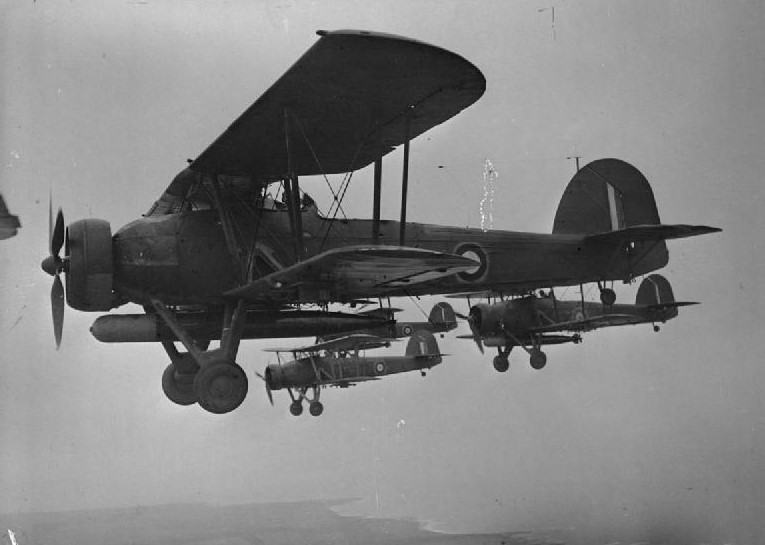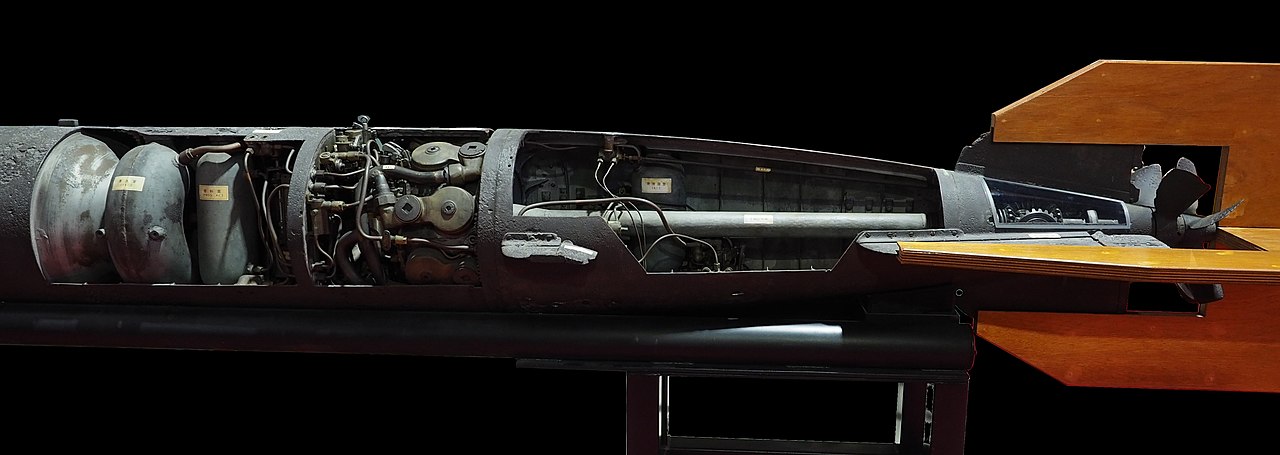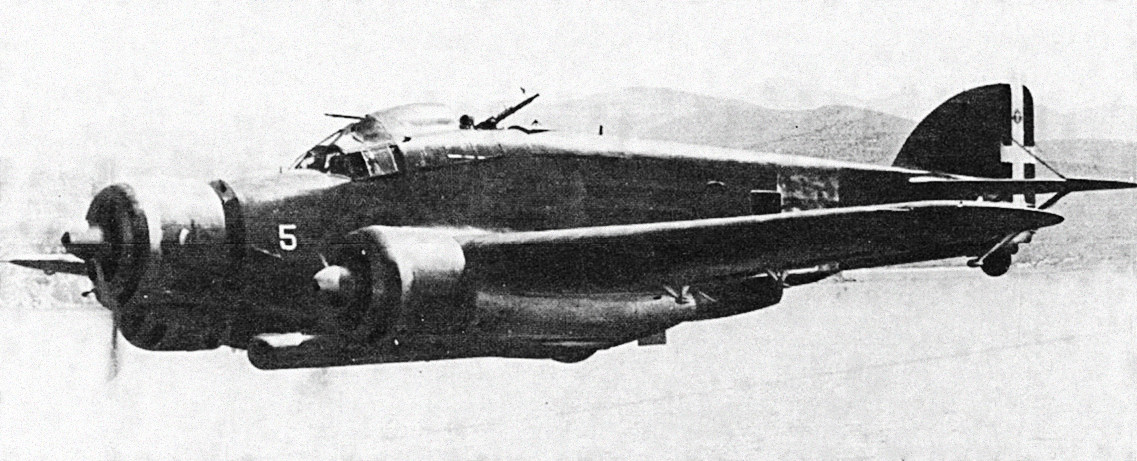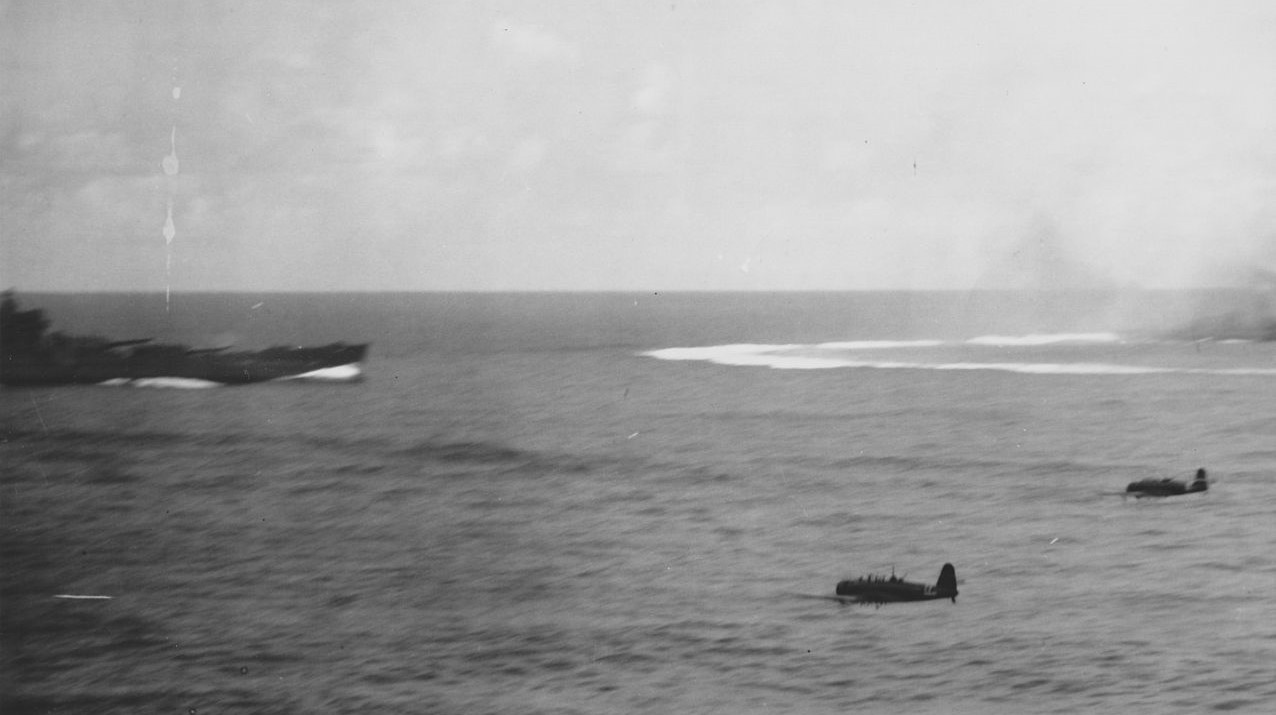The torpedo had long been the best way to let water into a ship, which is ultimately what was required to sink it, and it was clear from WWI onward that this would be a major weapon in the arsenal of the airplane. But early torpedoes were imposed strict limits on the speed and altitude of the dropping aircraft. Even in 1930, this was rarely more than 100 kts and 50'.

A flight of Swordfish torpedo bombers
By this point, it had became clear that the solution to the dropping problem would have to involve some sort of attachment to the torpedo to help keep it on course during its flight through the air. The idea seems to have originally been developed by the Norwegians, who fitted their torpedoes with an "air tail" consisting of wooden and canvas flaps that were operated by the torpedo's normal gyro mechanism and which separated on impact with the water. Most nations used some variant of this idea, often including both a wooden stabilizer and some method of roll control, all of which allowed drops from greater speed and altitude, a process that also saw torpedoes strengthened to withstand the greater force of impact. The British, sharply weight-limited, were forced to drop an example of their torpedo at greater speeds until something broke, strengthen that thing, then repeat the process until the next thing failed. Despite this, their program was quite successful, with the Monoplane Air Torpedo tail system giving a standoff range of 3,000 yards or more and late versions allowing release at up to 300 kts.1 At the outbreak of war, the Japanese were probably the world leaders in this, with the Type 91 Mod 2, which had been subjected to extensive drop tests in the interwar years, capable of dropping from 330' and 200 kts.
It was these torpedoes that were famously used at Pearl Harbor. Purportedly, they were fitted with wooden tail fins to keep the weapons, which usually plunged to 100' or so before stabilizing, from plowing into the 40' bottom of Pearl Harbor. However, on looking into exactly what was done, it appears that this isn't true, per this exhaustive blog article. In fact, the wooden tail was apparently the standard air tail that was developed during the 30s. Instead, the modification for the Pearl Harbor attack was to fit extended breakaway fins to the forward anti-roll ailerons that stabilized the torpedo in the water, allowing them to work in the air as well. This in turn allowed the elevators to be set fully up on water entry, avoiding the "hooking" problem discussed last time.2 Despite this, the Kates which dropped the torpedoes had to make their attacks from 65' and 140-150 kts. The precise altitude was a particular problem, as the radar altimeter had yet to be invented and pilots generally had trouble judging altitude, leading to many high releases in action. But the skilled Japanese pilots were able to make it work with devastating results.3

The fins and operating mechanism of the Japanese Type 91 torpedo
The Germans began by licensing the Norwegian torpedo for aerial use, although they had trouble making it work, particularly at speed, and later switched their production to Whitehead models.4 They were very focused on high speeds and altitudes, which may have accounted for their reluctance to adopt new models. Notable was the development of two rocket-propelled torpedoes, as well as one powered by a Walter engine, more famously used in the Type XVII U-boat, although none of these saw operational service. The Germans also made use of Italian torpedoes, which were generally quite good, particularly by the standards of torpedoes in use at the start of the war. Another notable facet of the German and Italian torpedo programs was the almost total reliance on medium bombers as torpedo platforms. While all powers planned to make use of twin-engine bombers flying from land bases, combat usage varied widely. The Americans didn't develop the concept until after Pearl Harbor thanks to suspicion by the Navy of Army encroachment on maritime missions, then tried it once, at Midway, before deciding that it was silly and abandoning the idea.5 Germany and Italy never did anything else, probably because their lack of carriers meant they never developed good single-engine torpedo bombers. Japan and Britain were in the middle, although the Japanese twin-engine torpedo bombers did considerably better in action than their British counterparts, most notably in the sinking of Force Z.

An Italian S.M.79 torpedo bomber
Torpedo tactics varied widely during the war. For attacking large ships, massed attacks were obviously necessary, although pressing these home in the face of heavy AA fire took discipline. The British found that Italian torpedo attacks on fleet units could be rendered ineffective by barrage fire, which would force the Italian pilots to drop early.6 This tactic didn't really work for convoys, which couldn't muster nearly as much firepower, and even if there was enough firepower to deter the torpedo bombers from closing, the slower merchant ships were vulnerable to long-range "browning shots", where the torpedoes were fired in the general direction of the convoy under the assumption that some of them would find their targets. Unlike warships, they weren't very good at dodging, and a single torpedo might well be enough to sink one. Later in the war, US torpedo bombers began approaching in fairly steep dives (possibly up to 60°, although sources aren't always great at distinguishing between glide bombing and torpedo attacks) which allowed them to bypass screening units and push attacks home in the face of strong AA fire.

Kate torpedo bombers approach South Dakota at Santa Cruz
The lack of good radar through the early years of the war meant that smokescreens were often a good counter to torpedo bombers, although night frequently wasn't. In fact, the torpedo dominated night attacks on ships, as the operator had a relatively long time to line up on the target relative to other methods of attack, and had only one dimension of potential error. Taranto was the most famous demonstration of this, but the Americans also operated "Black Cat" PBYs in the Solomons, often loaded with torpedoes to attack the Tokyo Express. The Japanese also made extensive use of night torpedo attacks starting in 1943, initially by single aircraft attacking with the aid of flares and the moon, but later en masse, and the threat of such attacks was a major driver of blind-fire AA weapons and night carrier operations.
But there has been one nation mostly unmentioned in all of this: the United States. They were often the weirdest of the major powers in their approach to aerial torpedoes, a story I will tell next time.
1 It is worth noting the existence of a system known as "Bootleg", a rocket-boosted torpedo that would be toss-bombed towards the target. It would have been a 20" weapon with a 575 lb warhead, launched 5,000 yards from the target and capable of 70 kts in the water. Unfortunately, it was never introduced into service. ⇑
2 Yes, I know I said this was a more general issue earlier. I'm working from scattered sources here, and suspect different navies had different tradeoffs between hooking and the torpedo going deep. ⇑
3 There's the obvious question of what happened at Taranto. The blog post linked above claimed that the torpedoes were attached to the Swordfish using wires, although Friedman seems to indicate that that system was gone by 1940. David Hobbs says merely that the torpedo crutches were modified to ensure that the torpedoes were dropped with "their noses just below level". Given that the citation for the wire thing is a personal account from decades later, and the British use of a similar system earlier which he may have gotten confused, I suspect that the British torpedoes generally plunged less than the Japanese ones did, and no wires were used. ⇑
4 This may have been because the Luftwaffe controlled all aviation, and the Kriegsmarine had no interest in smaller, lighter torpedoes for aerial use. ⇑
5 Well, mostly. US medium bombers continued to have torpedo fittings throughout the war, and the USAAF developed and used the GT-1 glide torpedo, while the Soviets used Lend-Lease A-20s as their primary torpedo bomber. ⇑
6 This probably contributed to their confidence that they could handle Japanese air attack in the opening days of the Pacific War. ⇑

Comments
So AAoS:Dive Bombing will be part 5?
That's the plan, yes. Probably 5 and 6, although that depends on sourcing.